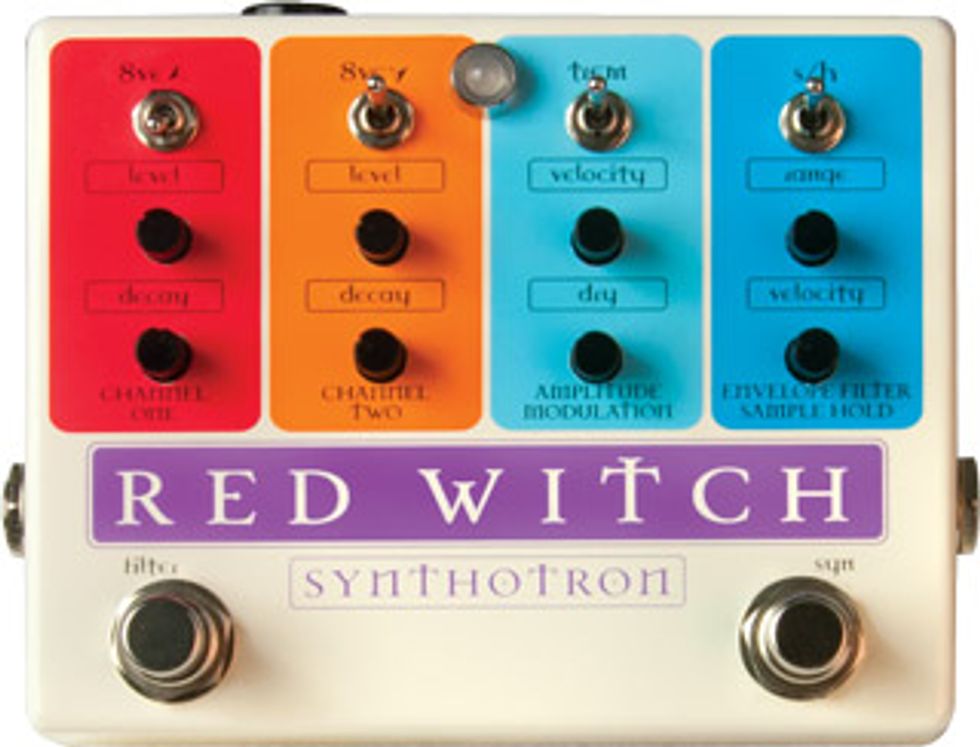
For guitarists who dig the electronic sound of a synthesizer, guitar synth pedals can combine the best of both worlds—the psychedelic glow, glitchiness, and fat tones of a synth’s oscillators with the expressiveness of guitar strings. There are a handful of such devices on the market that use a guitar signal to drive synth oscillators inside a pedal. And depending on the implementation, the results can range from swooping UFOs, to buzzing leads, to chugging synth bass.
Synth pedal controls and parameters can differ wildly and prioritize different aspects of synthesis. Red Witch’s Synthotron, which is a synthesizer, sample and hold, and envelope filter, takes an ambitious but streamlined approach by packing a lot of sound-sculpting features into a box that can be a handful at times, yet yield spectacular results.
Expansive Synth Controls
Outwardly, the Synthotron is a
delicious fusion of ’70s graphical
concepts (there’s more than a
few hints of Mu-Tron design in
the multi-colored enclosure) and
Red Witch’s forward-thinking
design notions. The pedal is built
around a synth engine divided
into three sections—octave up,
octave down, and tremolo—as
well as a filter section. Each section
is assigned its own colored
block, which helps orient you
on the fly. The left footswitch
engages the filter and its
controls located
on the right side
of the pedal (which
is a tad counterintuitive),
while the right footswitch
engages the synth section. And
being able to run either side
independently or in combination
really opens up the sonic
possibilities of the Synthotron.
On the Synth Side
The Synthotron is a 2-channel
synth pedal, which means that
the tracked pitch from your
guitar controls the pitch of two
separate square-wave oscillators.
Square waves are a common
choice in synth pedals because
they sound buzzy—not unlike a
distorted guitar—but also have
a very evocative video game-like
sound, which can be heavy,
funky, or hilarious depending
on how you use it. The
Synthotron’s square-wave tone,
however, is a fat, rich foundation
for tweaking.
The first channel can be set to one or two octaves up, and the second channel can be set to one or two octaves down. Each octave channel has a dry level knob, which controls the balance of effected and clean signal, and a decay knob that dictates the sustain of the synth signal. The last effect on the synth side is a tremolo channel that, like the octave-up and octave-down channels, can be bypassed via a mini-toggle.
The filter section controls an envelope filter that produces an auto wah-like effect and the range control determines whether the sweep occurs across higher or lower frequencies.
There’s also a sample-and-hold switch, which overrides the envelope. This moves the filter position around in an unpredictable, floating fashion. There’s also a control that sets the speed of the sample-and-hold generator. Faster settings produce the sound of a robot in deep thought. Slower settings bring to mind the drifting, psychoactive states.
Ratings
Pros:
Rich analog synth tone. Sample-and-hold filter.
Compact, considering its power. A tweaker’s delight.
Cons:
Control layout and labeling are not entirely
self-explanatory.
Tones:
Ease of Use:
Build:
Value:
Street:
$399
Red Witch Pedals
redwitchpedals.com
Gateway to Gonzo
One of the most important
qualities of any pitch tracking
effect is its ability to accurately
register the pitch of your instrument’s
signal. Some players
want 100-percent perfect pitch
tracking. Other players prefer
the quirky, less-stable pitch
tracking common with vintage
analog synths. The Synthotron’s
tracking injects just enough of
that vintage quirkiness while
remaining musical. The pedal
also has an internal trim pot
that allows you to adjust the
pitch tracking sensitivity.
Because the synth tones are generated by the pedal itself, pickup selection on your instrument will not impact the actual synth sound. Pickup selection does produce slight variation in pitch tracking though, though my Strat’s single-coils tracked with ease, and my Gibson SG’s meatier humbuckers tracked more reliably than single coils. In any case, the Synthotron’s wet/dry control allows you to create an effect that blends in a subtle amount of square-wave buzz. Independent level controls for each of the two oscillators allow you to mix low and high octaves like you would with any flexible octave pedal.
The Verdict
The Synthotron packs a lot of
analog synth power into a small
package. Given its small size,
the pedal’s ability to perform
dual-voice analog synthesis,
tremolo, filtering, and sample-and-hold is impressive. The
independent mixing controls
give the player the ability to
strap on their chef ’s hat and
adjust signals to taste. Analog-synth
fans will appreciate the
pure analog circuitry of both
the pitch tracking circuits as
well as the oscillators.
And when you’re looking to step away from the synth, the Synthotron’s filtering channel can be used independently for funky, envelope-filtering effects. All these tone permutations, plus each effect’s ability to go from tame to unhinged, makes the Synthotron not just powerful, but practical and musical as well.







![Rig Rundown: Russian Circles’ Mike Sullivan [2025]](https://www.premierguitar.com/media-library/youtube.jpg?id=62303631&width=1245&height=700&quality=70&coordinates=0%2C0%2C0%2C0)

















